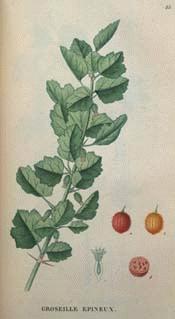
Botanical.com Home Page

|
European gooseberry
(Ribes uva-crispa
printed as Ribes Grossularia)
Click on graphic for larger image
|
Gooseberry
Botanical: Ribes grossularia
Family: N.O. Grossulariaceae
---Synonyms---Fea. Feverberry. Feabes. Carberry. Groseille. Grozet. Groser. Krusbaar. Deberries. Goosegogs. Honeyblobs. Feaberry.
---Parts Used---Fruit, leaves.
---Habitat---Central and Northern Europe, especially Britain. Ribes Uva Crispa, also, as far east as Nepal and south to Morocco.
---Description---The well-known fruit grows on shrubs 3 to 4 feet high, with many branches, spreading prickles, and small, three- or five-lobed, hairy leaves. The flowers are green and hang singly or in pairs from little tufts of young leaves. The berries may be red, green, yellow, or white, hairy (Ribes grossularia) or smooth (R. uva crispa), over 200 varieties being recognized. It is especially cultivated in Lancashire and in the Lothians, in Scotland, the former district aiming at size, and the latter at flavour. The shrub may attain great age and size. In 1821, at Duffield, near Derby, a bush had been planted for at least forty-six years, and was 12 yards in circumference, while two, trained against a wall near Chesterfield, reached upwards of 50 feet in growth from end to end.
The yellow gooseberries have usually the richest flavour for dessert, and the best wine made from them very closely resembles champagne. The red are generally the most acid, supporting the fact that acids change vegetable blues to red.
The fruit does not appear to be highly valued in the South of Europe, but further North is very popular for tarts, pies, sauces, chutneys, jams, and dessert, also for preserving in bottles for winter use. The young and tender leaves are eaten in salads.
---Constituents---Citric acid, pectuse, sugar, and mineral matters, the pectuse causing the fruit to be excellent for jellies.
---Medicinal Action and Uses---The juice was formerly said to 'cure all inflammations.' In the green berries it is sub-acid and is corrective of putrescent foods, such as mackerel or goose. The light jelly made from the red berries is valuable for sedentary, plethoric, and bilious subjects.
- As a spring medicine, gooseberry is more valuable than rhubarb. In one of the many books on the Plague, published in the sixteenth century, the patient is recommended to eat 'Goseberries.' Gerard, describing it under the name of 'Feaberry,' says:
- 'the fruit is much used in diners, sawces for meates and used in brothe instead of Verjuyce, which maketh the brothe not only pleasant to taste, but is greatly profitable to such as are troubled with a hot, burning ague.'
The leaves were formerly considered very wholesome and a corrective of gravel. An infusion taken before the monthly period will be found a useful tonic for growing girls.
---Dosage---Of an infusion of 1 OZ. of dried leaves to 1 pint of water, 1 teacupful three times a day.
[Top]
Common Name Index
A MODERN HERBAL Home Page
Bear in mind "A Modern Herbal" was written with the conventional wisdom of the early 1900's. This should be taken into account as some of the information may now be considered inaccurate, or not in accordance with modern medicine.
© Copyright Protected 1995-2025 Botanical.com
|

